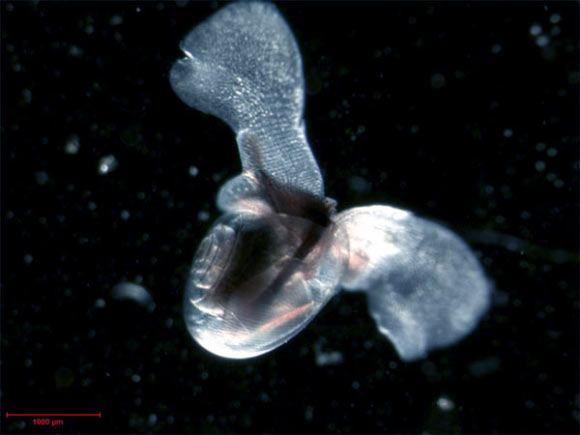Zooplanktonic sea butterflies (Limacina helicina) ‘fly’ underwater using the same technique as tiny flying insects, beating their wings in a figure-of-eight pattern, says a team of researchers at the Georgia Institute of Technology.

The sea butterfly (Limacina helicina). Image credit: Russ Hopcroft, Institute of Marine Science, University of Alaska Fairbanks / NOAA.
Limacina helicina is a pelagic sea snail known as the sea butterfly. This zooplanktonic species is ecologically important for the large biomass it maintains in polar ecosystems.
Furthermore, because its shell sinks when the animal dies, Limacina helicina is geochemically important as a major conduit of carbon to the deep ocean.
In temperate regions, Limacina helicina reaches shell diameters of 1-4 mm and swims at speeds of 10–50 mm/s, whereas in the sub-Arctic, their shells may grow to 14 mm, with swimming speeds reaching 120 mm/s.
“Most zooplankton swim with a drag-based paddling technique,” said Dr. David Murphy from the Georgia Institute of Technology’s School of Civil and Environmental Engineering, lead author on a study published in the Journal of Experimental Biology.
“Sea butterflies and flying insects stroke their wings in a characteristic figure-of-eight pattern to produce lift, and both generate extra lift by peeling their wings apart at the beginning of the power stroke (the well-known Weis-Fogh ‘clap-and-fling’ mechanism).”
Dr. Murphy and co-authors built a 3D system to visualize fluid movements around minute animals.
“Working with Limacina helicina in land-locked Atlanta posed a unique set of challenges,” the scientists said.
“Sea butterflies are scarce at the best of times and that transporting the fragile gelatinous creatures across the continent from their ocean home was tricky.”
“You have to ship them overnight in an insulated cooler to keep them cold and if the water is too dirty particles will stick to them, so the water has to be very clean.”
The scientists were astonished when they realized that the snails were swimming just like fruit flies fly.
“I said to myself: its wing stroke is just like what an insect is doing,” Dr. Murphy said. He and his colleagues were impressed to see that the mollusks generated the same low-pressure system that produces lift in flying fruit flies.
“The snails — and fruit flies — clap their wings together at the top of a wing beat before peeling them apart, sucking fluid into the V-shaped gap between the wings to create low-pressure vortices at the wing tips that generate lift.”
“No one has actually been able to measure the flow around an insect doing this while it is flying, and so that was kind of the holy grail of this area of research.”
“It really surprised me that sea butterflies turned out to be honorary insects,” Dr. Murphy said.
_____
David W. Murphy et al. 2016. Underwater flight by the planktonic sea butterfly. Journal of Experimental Biology, vol. 219, no. 4, 535-543; doi: 10.1242/jeb.129205







